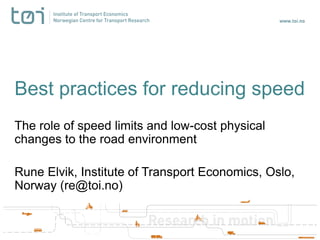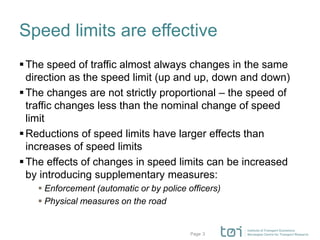Best practices for reducing speed rune elvik
- 1. Best practices for reducing speed The role of speed limits and low-cost physical changes to the road environment Rune Elvik, Institute of Transport Economics, Oslo, Norway (re@toi.no)
- 2. Effects of changes in speed limits on the mean speed of traffic 15.0 Dotted straight line = line of proportionality = equal percentage changes 10.0 Change in the mean speed of traffic (km/h) - vertical line 5.0 0.0 -40 -30 -20 -10 0 10 20 30 -5.0 -10.0 -15.0 y = -0.0058x2 + 0.2781x - 0.2343 R² = 0.5404 -20.0 -25.0 Change in speed limit (km/h) - horizontal line Page 2
- 3. Speed limits are effective  The speed of traffic almost always changes in the same direction as the speed limit (up and up, down and down)  The changes are not strictly proportional – the speed of traffic changes less than the nominal change of speed limit  Reductions of speed limits have larger effects than increases of speed limits  The effects of changes in speed limits can be increased by introducing supplementary measures:  Enforcement (automatic or by police officers)  Physical measures on the road Page 3
- 4. Low-cost physical measures  Speed humps  Cheap, effective and require minimal maintenance  Need to be placed densely to keep speed down on longer sections  Raised pedestrian crossings  Have similar effects as humps, but make crossing the road easier  Street narrowing – broader sidewalks  Also make crossing the road easier, but reduces its capacity  Chicanes – road narrowings in zigzag pattern  Are less effective than humps if the street has to remain wide enough for two cars to be able to pass without one of them having to stop and wait for the other Page 4
- 5. Effects of physical measures Percentage change in the number of accidents Best 95% confidence Accident severity Types of accidents affected estimate interval Speed humps Injury accidents All accidents on roads with speed humps -41 (-57; -34) All accidents on roads nearby roads with speed Injury accidents -7 (-14; -0) humps Raised junctions Injury accidents Accidents at junctions +5 (-34; +68) Property damage only accidents Accidents at junctions +13 (-55; +183) Rumble strips in front of junctions Injury accidents Accidents at junctions -33 (-40; -25) Property damage only accidents Accidents at junctions -25 (-45; -5) Unspecified Accidents at junctions -20 (-25; -5) Speed zones Injury accidents All accidents -27 (-30; -24) Property damage only accidents All accidents -16 (-19; -12) Page 5





